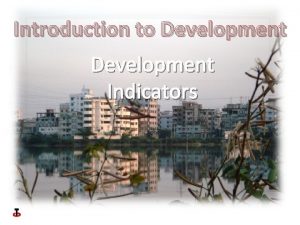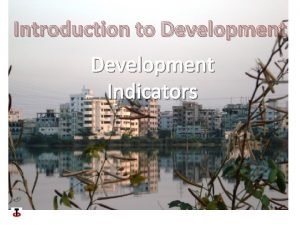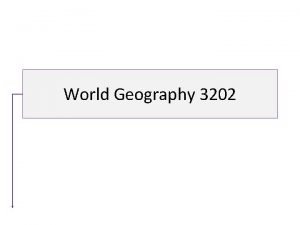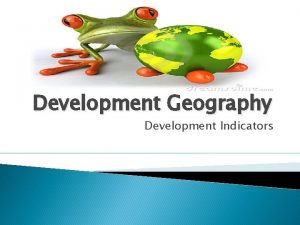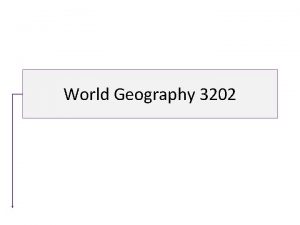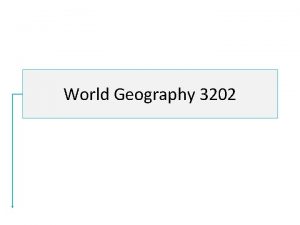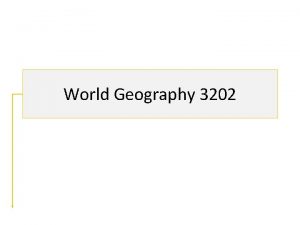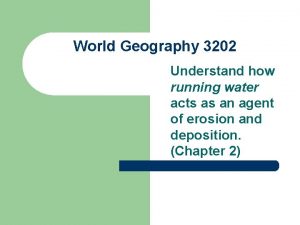World Geography 3202 5 8 Development Indicators 5

























- Slides: 25

World Geography 3202 5. 8 Development Indicators

5. 8. 1 Define the term gross national product (GNP). (k) GNP- Refers to the total value of all goods and services produced in a country during a specific period of time (ie: one month, one year, etc. ) Weakness- It is difficult to use this figure to determine standard of living in a country because it does not take into consideration the population of the country. For example, two countries may have the same GNP, but country 2 may have twice the populations. Thus, from this we could assume that the standard of living in country 1 is higher but we would not know this is we did not know the population of the countries.

5. 8. 2 Define the term per capita GNP. (k) Per Capita GNP- When we divide the GNP of a country by the population of that country we get the per capita GNP. This is a much more accurate measure to use when referring to the level of development within a country.

5. 8. 3 Relate per capita GNP to level of economic development. (a) In general places with a higher GNP have higher levels of economic development Developed nations have the highest levels of GNP: United States, Canada, Australia, Europe, Japan.

5. 8. 3 Relate per capita GNP to level of economic development. (a) HDI is a measure of development. This map shows how some of the worlds most biologically diverse areas are in some of the least developed countries

5. 8. 4 Relate employment structures to levels of economic development. (a) Economists have recognized that "developed" countries have been able to move their economy beyond the primary sector to the secondary sector which in turn grows the tertiary sector. developed countries have a much larger percentage of their work force employed in the secondary and tertiary sectors. Lesser developed countries have most of their work force employed in the primary economic sector.

100 80 60 Primary 40 Secondary 20 0 Burundi is typical of a lesser developed country it has a high percentage working in primary industry Tertiary Burundi Ghana Mexico United States Ghana and Mexico Are typical of developing Countries they have a Reduced amount of people Working in primary industries And growth in the secondary And tertiary industries They United States is Typical of developed Countries. The largest percentage is employed in tertiary industry. While primary industry employment is greatly reduced

5. 8. 4 Relate employment structures to levels of s e i r t economic development. (a)ree Coun ent h T pm e o l h e t v Rank er of De d r o n i Employment Structure for Country "X" Employment Structure for Country “Y" Employment Structure for Country "X" Primary sector 60% Primary sector 80% Primary sector 3% Secondary sector 15% Tertiary sector 25% Tertiary sector 10% Tertiary sector 82%

5. 8. 5 Explain why it is beneficial to use more than one indicator when describing the standard of living of a country. (k) It is quite dangerous to only use one indicator to classify the level of development in a country because that one indicator may be an outlier (ie: misleading, based upon many other indicators).

5. 8. 6 Relate selected social and economic indicators to level of economic development. (a) • There seems to be two aspects to development, economic (financial) and social (human). • Economic development refers to how well the economy is doing and how much money people have at their disposal. • Social development refers to more human indicators of well being such as life expectancy, infant mortality rate, literacy rate, availability of communications.

5. 8. 6 Relate selected social and economic indicators to level of economic development. (a) • There is some debate over which indicators are a better measure of development. • It is very likely that a variety of indicators is the best way to determine the level of development. • Generally speaking, people in more developed countries are better off and have an easier life than people in lesser developed nations. • To describe how well off people are, economists and sociologists use the term "standard of Living". Standard of living equates to quality of life.

5. 8. 6 Relate selected social and economic indicators to level of economic development. (a) Social Indicators Economic Indicators Population factors (Growth) GNP Life Expectancy Employment Structure Infant mortality % of population employed Access to drinking water Literacy rates Many More…. .

HIGH STANDARD OF LIVING • long life expectancy • equal rights • high average wages • strong economies • great health care • and high literacy rates LOW STANDARD OF LIVING • short life expectancy • discrimination against woman • very low wages • faltering economies • little health care • and very low literacy rates.

5. 8. 7 Analyze patterns in the distribution of selected socio-economic indicators with the patterns in the distribution of developed or developing countries. (a)

5. 8. 7 Analyze patterns in the distribution of selected socio-economic indicators with the patterns in the distribution of developed or developing countries. (a) Population Growth Rates

5. 8. 7 Analyze patterns in the distribution of selected socio-economic indicators with the patterns in the distribution of developed or developing countries. (a) Life Expectancy

5. 8. 7 Analyze patterns in the distribution of selected socio-economic indicators with the patterns in the distribution of developed or developing countries. (a)

5. 8. 7 Analyze patterns in the distribution of selected socio-economic indicators with the patterns in the distribution of developed or developing countries. (a)

5. 8. 7 Analyze patterns in the distribution of selected socio-economic indicators with the patterns in the distribution of developed or developing countries. (a) Employment Rates

5. 8. 7 Analyze patterns in the distribution of selected socio-economic indicators with the patterns in the distribution of developed or developing countries. (a)

Q. When economists calculate the percentage of people working in each economic sector the statistic created is known as the _? _. A. EMPLOYMENT STRUCTURE Q. _? _ refers to the total value of the production of goods and services in a nation measured over a year. A. GNP (GROSS NATIONAL PRODUCT). Q. _? _ is derived by dividing the GNP by the population of the country. A. Per capita GNP

Q. Consider the countries and their GNP's listed below. Which country would economists say is most developed ? • • Q. – – A. $1, 400 B. $20, 200 C. $7, 700 D. $6, 100 Consider the countries and their employment structures listed below. Which country would economists say is most developed? A. 46% primary 23% secondary 31% Tertiary B. 3. 4% primary 22% secondary 74. 6% Tertiary C. 14. 9% primary 32. 4% secondary 53. 2% Tertiary D. 56% primary 20. 8% secondary 23. 2% Tertiary

The United Nations Pledge!! The United Nations recognizes the disparity and has set forth eight "millennium goals" to reduce the disparity among nations. • By the year 2015 all 189 United Nations Member States have pledged to meet the list of goals. EIGHT "MILLENNIUM GOALS" • Eradicate extreme poverty and hunger • Achieve universal primary education • Promote gender equality and empower women • Reduce child mortality • Improve maternal health • Combat HIV/AIDS, malaria and other diseases • Ensure environmental sustainability • Develop a global partnership for development

The main reason is not because of ANY 1 factor BUT because three factors combined!

Read ALL of the statement!!!! Notice the end of the statement says “divided by the country’s population. ”
 Itu world telecommunication indicators database
Itu world telecommunication indicators database Development indicators
Development indicators Media development indicators
Media development indicators Development indicators
Development indicators Ap human geography political geography frq
Ap human geography political geography frq 5 themes of geography ap human geography
5 themes of geography ap human geography Proruption ap human geography
Proruption ap human geography World geography final jeopardy
World geography final jeopardy World geography spring final review
World geography spring final review Tertiary world geography
Tertiary world geography World geography terms
World geography terms World geography unit 9 lesson 1
World geography unit 9 lesson 1 World geography chapter 16 section 1
World geography chapter 16 section 1 Https://world-geography-games.com
Https://world-geography-games.com South america webquest
South america webquest How does wind affect weather and climate
How does wind affect weather and climate Highest peak in the world
Highest peak in the world 2021-2022 q1 9 week world geography cba
2021-2022 q1 9 week world geography cba World geography chapter 3 climates of the earth
World geography chapter 3 climates of the earth World geography unit 1 test
World geography unit 1 test Human geography today
Human geography today Cultural divergence ap human geography definition
Cultural divergence ap human geography definition World geography chapter 8 section 1
World geography chapter 8 section 1 World geography chapter 6 section 1
World geography chapter 6 section 1 World geography unit 1 vocabulary
World geography unit 1 vocabulary World regional geography
World regional geography

